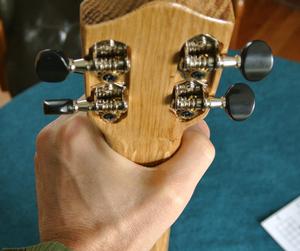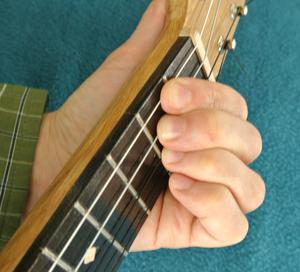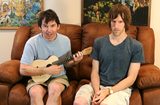

Aside from less attention to detail, my ukulele differs from typical tenor-sized ukuleles in that the scale length is slightly longer (45 cm or 18"), the neck is wider, and it has a floating bridge.
I figured the back of a guitar or ukulele contributed very little to the sound, but on the one Pat built, pressing the back of the instrument against the skin noticeably dampens the sound. So I guess the back matters more than I thought it did. On mine, the effect is less noticeable. The back of mine is 2.5 mm thick and made of heavier white oak, so it doesn't vibrate as much.
I also initially ran into some problems with strong resonance at the low G in my instrument, but stuffing a bit of felt into the body helped with that. That may also contribute to this one being less sensitive to touching the back.

A reader suggested to using a regular kitchen oven to bend the sides. If I build another one,
I will definitely try this. The idea is to bend the wood around a
form, similar to how I did, then bake the form with the clamped-on side in an oven
at maybe 300°F (150°C) to help set the shape. The form would need to be
made without any glue, and with the workpiece held in place by all-metal clamps or by screws.
This would probably cut down on spring-back a lot.
Update 2015: Chris Hoyle has tried this, and it works
Update 2020: I tried a kitchen oven for bending chair parts. Almost no spring-back.
Frets need to be comfortable to touch and to be levelled precisely, so it would be hard to come up with a substitute. One guy mentioned using the thin metal strips from windshield wiper blades, placed in slots. That might work and would be no less comfortable than pressing down on steel strings. Though a bit hard to level. Or you could just make the frets out of an exotic hardwood.
If your goal is to save money, it may make more sense to build a bandsaw, which is a comparable amount of work. A good bandsaw will easily cost $600. Or you could build a machine that can't be bought at any price, like the pantorouter :)
First off I'll say that working with Matthias has been a lot of fun, and I've enjoyed being exposed to his lateral thinking. Clever guy.
When we started off on this venture, I anticipated that he would be in my shop more often using some of my tools and jigs and asking me many questions. In fact, he wasn't over much and he asked few questions. Had he done so he could have saved himself some time and effort but, personally, I think the series has been much better because he didn't. What you have seen has been truly his approach and there's been something for everyone to learn (although I won't be anchoring my strings with screws any time soon). Most importantly what I hope people take away is that there is no magic to instrument building and if you just relax and go for it you surely will surprise yourself with the wonderful results.
I've noticed a few comments on forums where people have wondered what I think of his methods or what he's done so now I'll tell you. My opinion is that if something works for you, than it's a good method. So while some of the things Matthias did were "different", the bottom line is that he has built a great sounding ukulele that I'd take over most of those available in stores any day of the week. It has a nice, bright tone and good sustain. I would even begrudgingly admit that it sounds better than the one I show in our intro video and that one has a relatively expensive Engelmann Spruce top and Brazilian Rosewood back and sides! But Matthias did many things right. Most importantly he made the top thin and kept the bracing light. He also took care to get the frets well seated and level so his uke is quite playable. The only area where I thought he could have gone further while still remaining within the spirit of what he was doing was if he'd made the neck more rounded and lighter overall.
So again I want to come back to encourage others to give building a ukulele a try. I think Matthias has demonstrated that you don't have to be a specialist and you don't have to spend a lot of money on exotic woods to end up with something that plays and sounds great. And the humble uke has a lot to offer. On the one hand it's very accessible and you can very quickly be strumming some chords, and on the other you could spend a lifetime getting better all the time. It's hard not to get enthused. I had to talk Matthias into this and part of the fun for me has been seeing him go from "what do I want with a ukulele" to "it's hard to put this thing down". Hope you had fun too.
 Some fun with the ukulele
Some fun with the ukulele
Back to the ukulele page.
![]()